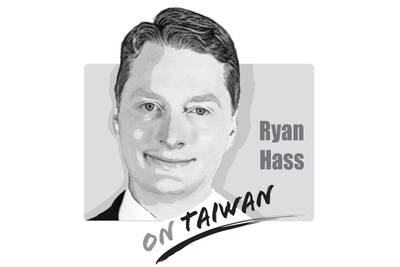Before the Referendum Law (公民投票法) was passed in 2003, Taiwan had already held referendums at the local level. Since a committee protesting the construction of a fifth naphtha cracker plant by CPC Corp, Taiwan in Houchin (後勁), Kaohsiung City, held the nation’s first referendum in 1990, there have been other referendums on various public issues.
In 1994, a referendum was held on the construction of the Fourth Nuclear Power Plant in Kungliao Township (貢寮) in Taipei County. In 1995, another referendum on the construction of the Fourth Nuclear Power Plant and a referendum on road construction in Sijhih (汐止) were held in Taipei County. Other referendums that year included another on nuclear power in Taipei City, one on the construction of Yongkang Park (永康公園) in Taipei City and one on the exploration of Daliao Township (大寮) in Kaohsiung County.
In 1997, a referendum was held on the reconstruction of Liaoting Community (寮頂) in Chiayi County and in 1998 a major investment project proposed by Bayer AG was put to a referendum in Taichung County.
The same year, a plebiscite was also held in Tainan City on Taiwan’s future.
All of these referendums lacked a legal basis, however, so the results were not legally binding. The results of the referendum on the construction of Yongkang Park, however, were recognized by the Taipei City Government as binding.
Since the Referendum Law was passed, six nationwide referendums have been held. In 2004, two plebiscites were held, one on increasing the nation’s purchase of anti-missile weaponry and one on negotiations with China on the establishment of a peace and stability framework. In January, two referendums were held in tandem with the legislative elections: the Democratic Progressive Party’s referendum on recovering the Chinese Nationalist Party’s (KMT) stolen assets and the KMT-proposed referendum on giving the legislature investigative powers.
Two more plebiscites were held in conjunction with the presidential election in March, both on seeking UN membership.
Although the results of each of the six referendums were affirmative, all were invalid because the total voter turnout fell below the legally specified minimum.
Before the Referendum Law became reality, it was impossible for the public to directly communicate their opinions on important issues to the government. It was not easy to pass this law. Without the efforts of academics, experts, civic organizations and the general public, legally binding direct democracy would never have been possible. However, the referendum system has repeatedly fallen victim to vicious political power struggles, which has led to boycotts that have taken advantage of the high threshold for valid results.
This has shown the deficiencies in the legislation, which must be amended in order for the act to serve its purpose: allowing the public a vehicle to communicate their will on crucial matters.
The government, political parties and the public each have an important role in deepening the nation’s democracy. The government has the obligation to promote referendums and inform the public about them in a fair and transparent manner. Political parties need to throw their weight behind an amendment to the legislation rather than boycotting referendums for their own ends. The public, meanwhile, has a duty to exercise its rights when there is a plebiscite.
Together, the government, political parties and the public should strive to expand the role of referendums in the nation’s democracy.
Chen Lung-chu is chairman of the Taiwan New Century Foundation.
TRANSLATED BY TED YANG

There has been much catastrophizing in Taiwan recently about America becoming more unreliable as a bulwark against Chinese pressure. Some of this has been sparked by debates in Washington about whether the United States should defend Taiwan in event of conflict. There also were understandable anxieties about whether President Trump would sacrifice Taiwan’s interests for a trade deal when he sat down with President Xi (習近平) in late October. On top of that, Taiwan’s opposition political leaders have sought to score political points by attacking the Lai (賴清德) administration for mishandling relations with the United States. Part of this budding anxiety
The diplomatic dispute between China and Japan over Japanese Prime Minister Sanae Takaichi’s comments in the Japanese Diet continues to escalate. In a letter to UN Secretary-General Antonio Guterres, China’s UN Ambassador Fu Cong (傅聰) wrote that, “if Japan dares to attempt an armed intervention in the cross-Strait situation, it would be an act of aggression.” There was no indication that Fu was aware of the irony implicit in the complaint. Until this point, Beijing had limited its remonstrations to diplomatic summonses and weaponization of economic levers, such as banning Japanese seafood imports, discouraging Chinese from traveling to Japan or issuing
The diplomatic spat between China and Japan over comments Japanese Prime Minister Sanae Takaichi made on Nov. 7 continues to worsen. Beijing is angry about Takaichi’s remarks that military force used against Taiwan by the Chinese People’s Liberation Army (PLA) could constitute a “survival-threatening situation” necessitating the involvement of the Japanese Self-Defense Forces. Rather than trying to reduce tensions, Beijing is looking to leverage the situation to its advantage in action and rhetoric. On Saturday last week, four armed China Coast Guard vessels sailed around the Japanese-controlled Diaoyutai Islands (釣魚台), known to Japan as the Senkakus. On Friday, in what
On Nov. 8, newly elected Chinese Nationalist Party (KMT) Chairwoman Cheng Li-wun (鄭麗文) and Vice Chairman Chi Lin-len (季麟連) attended a memorial for White Terror era victims, during which convicted Chinese Communist Party (CCP) spies such as Wu Shi (吳石) were also honored. Cheng’s participation in the ceremony, which she said was part of her efforts to promote cross-strait reconciliation, has trapped herself and her party into the KMT’s dark past, and risks putting the party back on its old disastrous road. Wu, a lieutenant general who was the Ministry of National Defense’s deputy chief of the general staff, was recruited